Well-groomed hands are as important for a woman as her face. But if we spend a huge amount of time on our face, we often leave our hands unattended. Or we limit ourselves to moisturizer and manicure. For many, such a careless attitude towards their hands becomes a fatal mistake. Today we’ll talk about what professional hand care includes and how to take care of your hand skin at home.

Features of aging hands
Skin aging begins earlier than we all used to think. Visual signs of this process appear on the hands much faster than on the face. At the age of 25-27 years, aging mechanisms are launched in a woman’s body: the synthesis of collagen and elastin fibers decreases, the processes of skin restoration and renewal slow down, and “skin breathing” becomes difficult. All this leads to the formation at a young age of a fine network of wrinkles on the hands, pronounced venousness and dry skin. Impaired melanin production can cause the formation of age spots. In addition to the natural aging processes, in everyday life we add problems to our hands with the help of aggressive household chemicals, neglect of sunscreen in summer and gloves in winter.
In order to avoid premature aging of the skin of your hands, it is necessary to provide them with proper daily care.
Basic rules for daily hand care
Daily hand care involves following a few simple rules:
- You need to wash your hands with water at room temperature. Hot water leads to dehydration. This makes the skin on your hands dull and unsightly.
- After each hand washing, it is necessary to apply a moisturizing or nourishing cream.
- All housework that involves the use of household chemicals must be done with special rubber gloves.
- Cosmetic hand care procedures, which we will talk about later, should be carried out regularly.
Hand hygiene
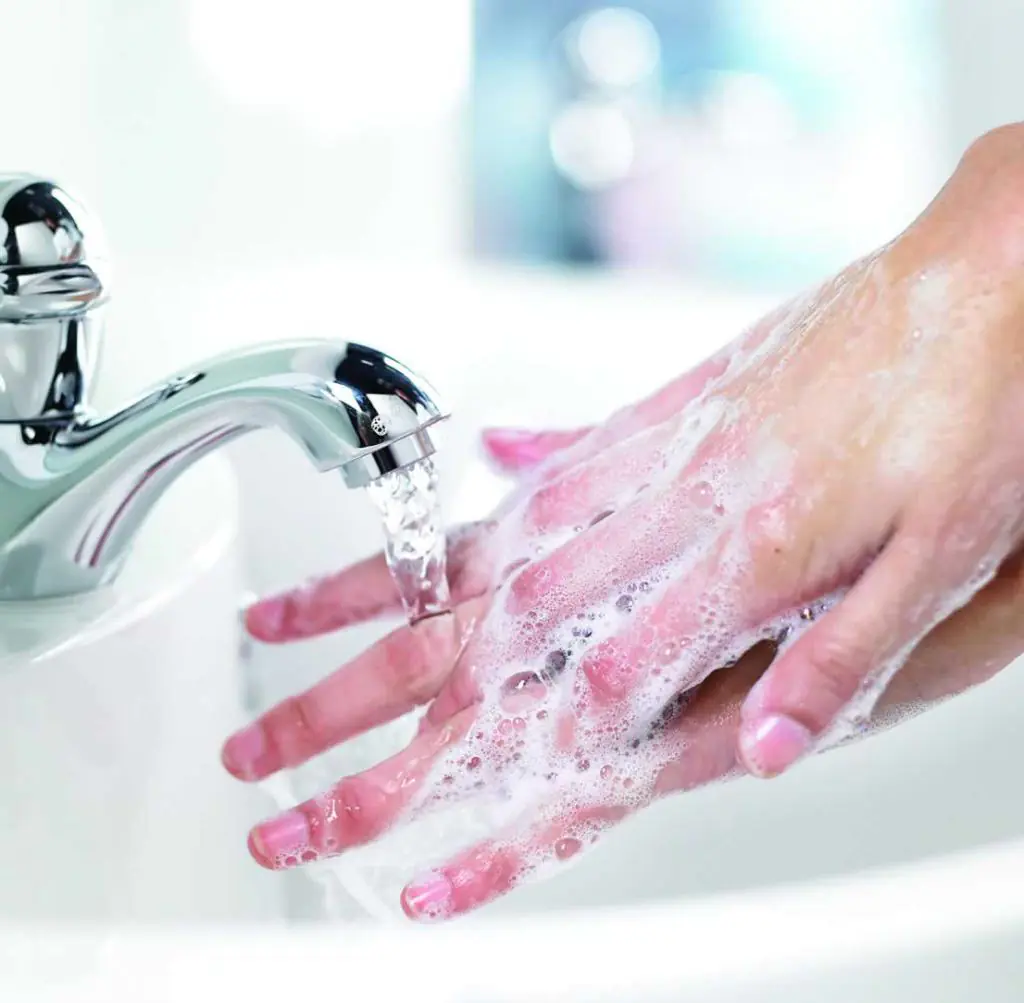
Probably, each of us in childhood was repeated the golden rule that we need to wash our hands every day. Hand hygiene is important not only for our health, but also in order to preserve their beauty and youth for a long time. Therefore, we will devote a few lines to how to wash your hands correctly, when it is necessary to do so.
Let's start with the fact that, as mentioned above, you need to wash your hands every day and more than once. Here are the points after which hand washing is a mandatory procedure.
- Before you start cooking.
- After contact with raw meat and fish.
- After the toilet.
- After contact with dirty objects: garbage, dirty laundry, etc.
- Before touching your face.
Hand washing should last about 20-30 seconds using water and soap. Preference should be given to liquid soap or a variety that foams well. It is best for the soap to contain betaine (a natural moisturizer), various oils and other moisturizing ingredients. Antibacterial soaps are best avoided. Our task during hand treatment is to remove dirt, and not to destroy the microflora of the skin of the hands. In addition, antibacterial soap can be aggressive and further dry out the skin. After washing, apply a moisturizing cream to care for your hands.
Features of hand care at different times of the year
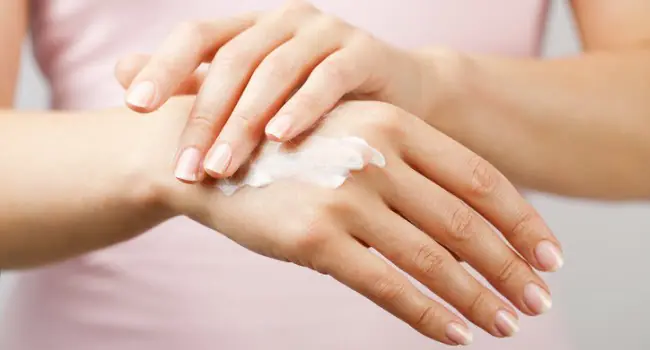
At different times of the year, the skin of your hands requires different care. This is due to changes in both the weather (winter frosts, summer heat) and our lifestyle (we are more active in spring and summer than in winter and late autumn).
In spring, hands need additional nutrition. To compensate for nutritional deficiencies, a fatty cream is used. It is recommended to do hand baths once a week. These can be either bath products from the professional hand care series, or a regular infusion of chamomile and calendula herbs. Various masks based on natural oils can help remove flaking at this time of year.
In summer, the skin of your hands is exposed not only to dust and dirt, but also to active solar radiation. Therefore, hand cream must contain SPF. Relaxing baths with oils are well suited for this period. And most importantly, avoid hand products that contain alcohol. They greatly dry and dehydrate the skin.
The main rule of the autumn/winter period is to protect your hands from frost. Don't neglect gloves or mittens. Hand cream should be nourishing. And it should be used after each contact with water. It is better if the cream is from a professional hand skin care series. It’s better not to skimp on your beauty and health.
Professional hand care
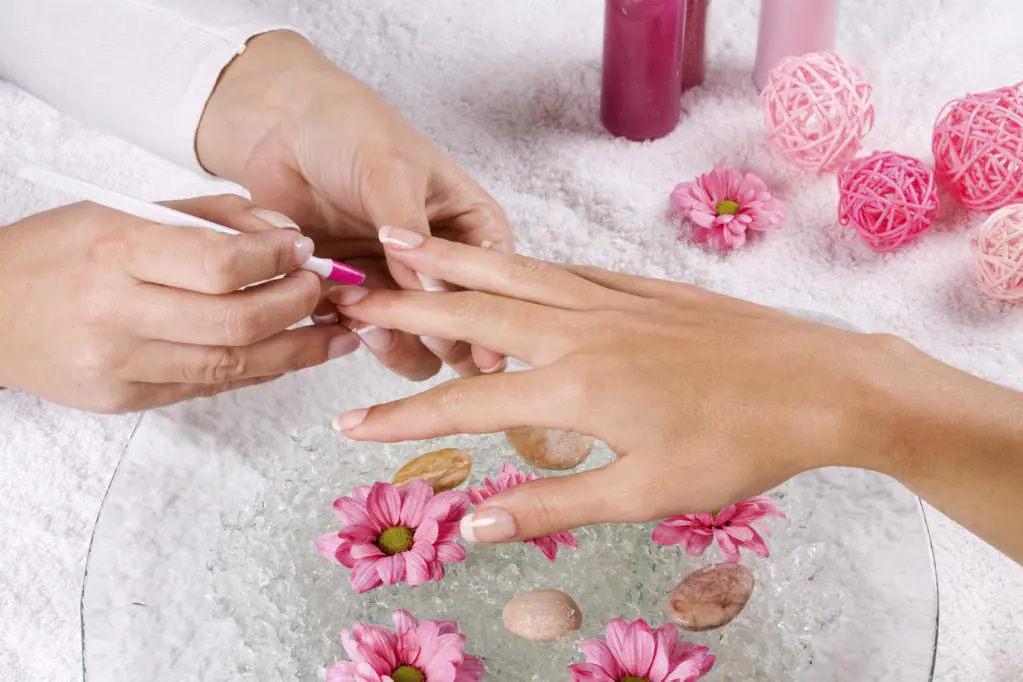
Beauty salons and spa centers offer their visitors a variety of high-quality hand skin care treatments. Let's look at the most popular and effective ones.
- Hand massage. Hands, like other parts of the body, need relaxation. Massage is perfect for this. It can be an additional service to the spa care complex, or be an independent procedure. Acupressure hand massage is especially useful. Thanks to the delicate influence of the master on certain points, not only the hands relax, but also a healing effect on the entire body.
- Paraffin therapy for hands. Many people have heard about her. But not everyone knows what it is for. Thanks to this procedure, the skin becomes softer and velvety. The issue of cracks and peeling of sensitive skin is resolved. The maximum effect of paraffin therapy is visible after a course of 10 procedures. They are held every other day. During the procedure, professional hand cosmetics are used. Paraffin therapy is carried out in five stages. First, the client’s hands are treated with a cleansing spray, after which the master performs a hand peeling procedure. The main task of peeling is to remove all dead skin particles. Thus, the effect of the procedure increases significantly. After cleansing, an emulsion containing 3% elastin and 5% collagen is applied to the hands. After applying it, a layer of paraffin is applied to your hands. You need to sit with this compress for 10-15 minutes. After this, the paraffin is removed. Special milk is applied to the hands. Paraffin therapy is a very useful and pleasant procedure. It works especially well in the off-season. When the skin of your hands needs additional care.
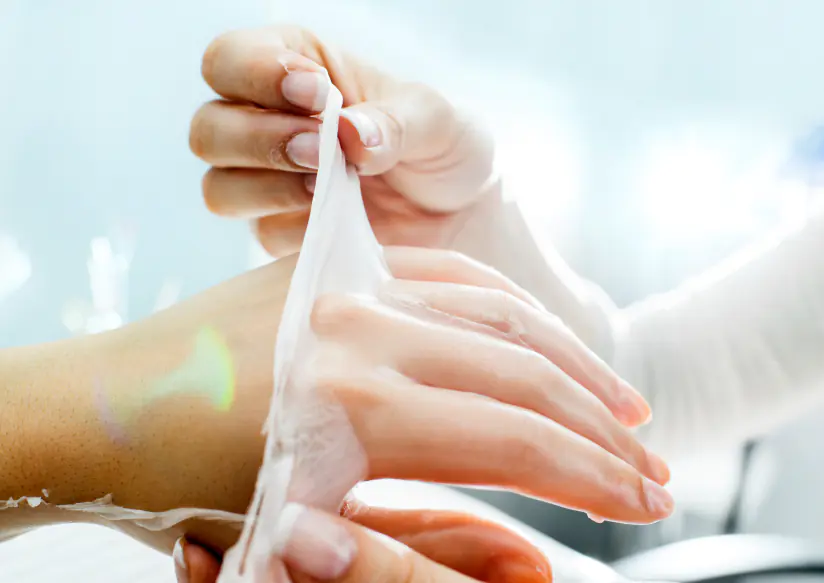
Hand mesotherapy
I would like to say a few words about hand mesotherapy. This is a popular and effective method of rejuvenating the skin of the hands. It fights age-related changes such as pigmentation, fine wrinkles, uneven skin texture, etc. It is carried out by injecting a special cocktail under the skin. The preparation contains vitamins, hyaluronic acid and other active ingredients. The recovery period after the procedure takes from 3 to 7 days. The result is visible immediately after restoration.
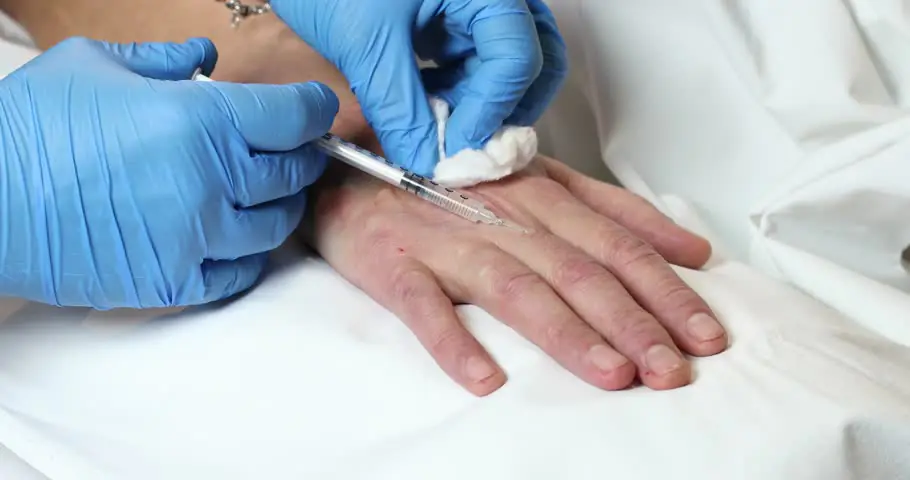
Additional hand treatments
- Peeling. This procedure is constantly used in professional hand care. Thanks to peeling, the skin of the hands becomes smoother, the color is evened out, and pigment spots become less noticeable. It can be of two types: mechanical and acid. For aging skin, the use of glycolic peeling is recommended. It makes the skin softer and more elastic. It is best to do this procedure in combination with a hand massage. This way the components will be able to penetrate deeper, and the effect of such procedures will be more noticeable.
- Hand baths. This is a very simple and effective procedure. Most often, baths are made using natural oils or herbal infusions. They help relieve fatigue and combat irritation and dry skin.
Differences between professional hand cosmetics and products for home use
The modern cosmetics industry provides us with a huge selection of various cosmetics for hand care. These can be either expensive professional series or high-quality budget products. Before we talk about cosmetics, let's figure out how professional hand cosmetics differ from ordinary ones.
- Package. Jars with professional products have a simple, laconic design and convenient packaging. The fact is that they are designed to work in beauty salons, where colorful inscriptions are of no interest to anyone. On the contrary, the packaging of products for home use should be beautiful and attract attention.
- Volume. Professional cosmetics are always produced in large volumes. It is designed for a flow of clients. Sometimes such products can be found in small packages. But the price will differ slightly from traditional tubes.
- Compound. Professional hand care cosmetics may differ in composition. For example, the acid content in a professional peel will be much higher than in a home product. Such products require compliance with the instructions for use. Improper use of such funds can cause harm instead of benefit.
Now let's look at the most popular hand skin care products.
Peelings and hand scrubs
These products are designed to deeply cleanse the skin of your hands. They differ from each other in composition. Scrubs contain solid particles. These can be crushed fruit seeds, dry herbs, polymer granules, etc. Peels work using various acids: lactic, mandelic, hyaluronic, etc. Such products are available in almost all lines of cosmetic hand care products. The scrub is also easy to prepare at home using natural coffee, salt or sugar.
Hand masks
Masks are an excellent cosmetic product not only for the face, but also for the hands. They deeply nourish and restore the skin. Regular use of masks can improve the visual condition of the skin, relieve it from irritation and peeling. Modern masks are very easy to use, and the results are noticeable almost immediately.
Hand masks can be produced both in regular tubes (which is very economical) and in disposable sachets. To make the effect of the procedure more noticeable, it is better to wear special gloves after applying it to your hands. In the budget segment, we recommend paying attention to the products of the Velvet Handles brand. These products are additionally enriched with vitamins for the skin of the hands. This makes the product truly effective.
Bath solutions
For those who do not like to brew herbs and mix various oils, manufacturers of hand skin products have released ready-made bath compositions to the market. They are sold in all cosmetic stores. The composition of such baths may include various oils, extracts of medicinal herbs, various soothing and moisturizing components.
Before purchasing such a product, carefully read their action and composition. Sometimes the components included in these products can cause allergies. If the composition contains salt, then it should not be used on damaged areas of the skin.
The contents of the bottle must be added to heated water, and the handles should be dipped into this solution. These baths are good to do before bed. They have a pleasant relaxing effect.
Creams and their benefits
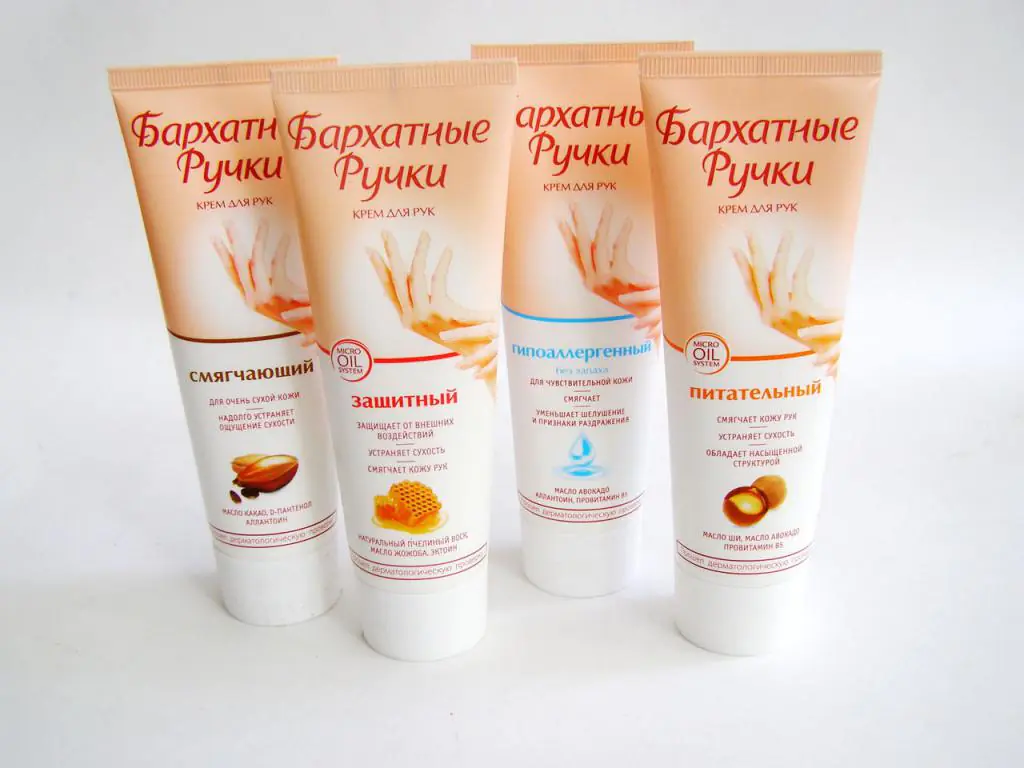
Hand care cream is a product that needs to be applied daily. It prevents skin dryness and performs protective functions. Hand cream can be moisturizing and nourishing. The choice of product depends on the time of year and skin condition. For example, in winter the skin needs intensive nutrition, and in summer the hands need additional hydration.
When choosing your product, pay attention to the Velvet Hands moisturizing hand cream. This brand has proven itself well over many years of work. There are a large number of positive reviews about this hand cosmetics.
As Coco Chanel said, a woman’s hands are her calling card. Therefore, do not be lazy, devote at least 15 minutes a day to them, and the result will not be long in coming.
Arms and legs are often the parts of the body that many people forget about when it comes to beauty. No matter how good you look, roughness and dryness hands will noticeably worsen your overall appearance, and unkempt legs will steal the elegance from your gait.
The biggest “beauty mistake” is that people don’t think about how to properly care for their hands and feet. They take care of their face, while other parts of the body do not receive even that much attention.
What are the problems associated with arms and legs?
One of the main problems is dryness combined with roughness of both hands and feet. Cracked heels are another problem familiar to many. This all becomes especially obvious and aggravated in the summer, when our hands and feet are directly exposed to harmful ultraviolet rays, which leads to dryness, premature aging, darkening of the skin and various rashes.
And in the soaring heat of summer, feet in closed shoes are very vulnerable to fungal infections, psoriasis, calluses, and, of course, to an unpleasant odor.
Hand care
Let's start with the hands. To have beautiful, well-groomed hands, you need to get your nails done regularly. We'll tell you how to do a simple manicure at home.
First, collect everything you need for the procedure. The essentials are nail polish, nail clippers, nail polish remover, cotton pads/swabs, cuticle pusher, cuticle remover, moisturizer, base coat and other things you think are necessary.
Place one hand in a bowl of warm, soapy water and wash it well; you can also add a few drops of an essential oil of your choice to the water.
Wipe your hand with a dry towel and apply cuticle remover cream for 10-15 minutes.
Wipe your nails with a cotton pad soaked in nail polish remover, removing any remaining polish and degreasing them.
Use good nail scissors to shape your nails into the desired shape and apply a little lemon juice to reduce the yellowness. Finish the shape with a nail file.
Now apply lotion or hand cream to your hands, leave for 10 minutes so that the skin has time to feel renewed.
Now you can paint and decorate your nails, not forgetting to apply a protective base before painting.
Hand care rules
Several recommendations on how to protect your hands during the day.
Don't forget the gloves
Our hands are regularly exposed to negative external factors, including dry air, cold, and various chemicals. To ensure minimal harm, you must always have gloves on hand for all occasions.
— For cold weather, you should have leather, wool gloves or mittens.
— For household chores, stock up on latex or rubber gloves.
— For gardening, purchase textile gloves.
It is important to wash your hands properly
As a result of constant contact with water and soap, the skin of your hands begins to lose moisture and peel. To avoid this, you need to follow very simple rules.
- Do not use antibacterial soap unnecessarily and try to purchase soap without fragrances, as they are very drying and can cause irritation. The soap should contain moisturizing ingredients such as olive oil, aloe vera, jojoba oil.
— To preserve the natural protective layer of the skin, wash your hands with warm water. Hot water won't help you here.
— Stop using electric dryers and replace them with paper towels.
Remember to exfoliate and nourish
In addition to using hand cream, you should always have masks and scrubs on hand and apply them once a week.
— Make hand masks from available products. For example, mix half an avocado, a tablespoon of lemon juice and an egg yolk. Apply the mixture to your hands and leave for 20 minutes.
— A mixture of sugar and olive oil can be used as a scrub.
— Great advice for the lazy: when you use a scrub or mask for your face/body, apply it to your hands as well.
The need for regular hydration
A quality hand cream is as necessary as shampoo and soap, so choose it very carefully.
— Use hand cream as needed, but it is better to do it twice a day, morning and evening. If the skin on your hands is very dry, use cream after each hand wash. To get an even greater effect, after applying the cream, put cotton gloves on your hands and leave it to work overnight.
— Your nails also need hydration. Don’t forget about them when you use hand cream; you can buy a product with vitamin E for the cuticles.
— The skin requires not only external hydration, so do not forget to drink enough water.
— During the heating season, be sure to use a humidifier.
How to care for your hands
The use of sunscreen is mandatory
One of the main signs of aging is hyperpigmentation of the skin of the hands. The reason for this phenomenon lies in the sun's rays, and not at all in aging and improper functioning of the liver, as is commonly believed. It’s just that over the years there is a cumulative effect.
— Apply sunscreen to your hands regularly to prevent the formation of age spots.
— Citrus fruits are an excellent natural bleach. For example, you can periodically make masks for the skin of your hands from a mixture of 1 tbsp. l. lemon juice, 1 tsp. honey and 1 tbsp. l. milk.
— Sun protection factor SPF for creams should be at least 30.
How to take care of your feet
Feet are the part of the body that withstands harsh tests every time you leave the house. In summer, feet remain “trapped” in shoes, which can often cause infection. Improper care or lack thereof often leads to the appearance of cracks on the legs. Often cracks are a consequence of dry skin and irregular hygiene.
Here's what's important to know about proper foot care
1. Keep your feet in warm water regularly
The best way to take care of your feet is to regularly soak them in warm water. Thanks to this, you will get rid of fatigue. This method will also help you invigorate and increase blood circulation in your legs. Do this procedure regularly to have beautiful and rested legs.
This essential beauty product effectively absorbs excess moisture during the hot summer months. A quality scented powder will help your feet feel good and help you feel more energized throughout the day.
This will also relieve you from the problem of unpleasant odor. Use the powder often and in sufficient quantities, and then your feet will always be fresh and rested.
Sun protection isn't just for your face and hands. Under the influence of ultraviolet rays, the skin of the legs also suffers and becomes covered with pigment spots, so every time you go outside with your legs open, do not forget about a generous portion of sunscreen on your legs. This will save them from burns and pigment darkening.
4. Don't forget about your knees
Knees also need special care. Don’t forget to clean them regularly, otherwise during the season you will look bad in your favorite open clothes, no matter how well-groomed you are.
Feet care
Regular pedicures combined with a foot massage can work wonders. Below we will tell you about several procedures that you can do at home to get well-groomed and healthy feet.
The most basic thing you should take care of is cutting the nail properly and creating the shape. Use a good nail cleaner, then trim carefully, and cut evenly, because if you cut in a circle, you may end up with a very nasty ingrown toenail problem. Also, to avoid ingrown toenails, do not cut it too short.
Clean your feet by taking a bath in warm water. Add bath salts and let your feet soak in it up to your ankles. For best results, add a few drops of your favorite essential oil or herbal infusion. You can place a few pebbles or coarse sand at the bottom of the container; these are excellent massagers.
It is better to do baths at least once a week, lasting 15-20 minutes.
The next step is to exfoliate the skin on your feet. Apply cuticle remover cream to the base of each nail, leave, and in the meantime use a foot scrub to rid your feet of dry and dead skin cells. Be careful with the scrub, don't rub too hard. You can rub your heels with a pumice stone to get rid of rough skin.
After this, remove the cuticle using a cuticle pusher. Remove cuticles only with the help of cream; if you try to do this by trimming, you may find out what an ingrown toenail is.
After the previous procedure, wash your feet well with clean water and apply moisturizer. This is a very important component of care. It will protect the skin of your feet from possible cracks and make them soft.
Buy products that contain moisturizing ingredients such as lecithin and glycerin, and emollients such as lanolin, dimethicone, and petroleum jelly. Remember that it is better not to lubricate the areas between the toes, as this can lead to the appearance of fungus.
Massage your feet; regular massage stimulates nerve endings, improves blood circulation, nourishes the skin and strengthens the foot muscles. This is the best remedy that will keep your feet healthy and relieve fatigue. Try to devote 5 minutes to massage daily.
Buy a massager for this procedure or simply roll any round object on the floor.
- be sure to keep your feet dry
This is one of the basic principles of foot hygiene, since excessive moisture is the main cause of fungus. To keep your feet dry, follow a few simple rules.
Firstly, the skin must breathe, so choose shoes only from natural materials.
Secondly, dry your feet after taking a shower.
Third, don't wear the same pair of shoes for several days in a row.
If you still cannot avoid ingrown toenails, you can try to get rid of the problem as follows:
1) Immerse your feet in warm water for 15-20 minutes. To disinfect water, add 1 tbsp. l. regular salt per 1 liter of water.
2) Very carefully, use dental floss to pry the nail under it and lift it up a little.
3) Immediately treat the damaged area with an antiseptic and cover the area with a band-aid.
4) Do this every day until the nail recovers.
If the situation is serious, and the inflammation and redness only intensify, then do not self-medicate, consult a specialist.
Homemade recipes for hand and foot care
Foods that are almost always available in any kitchen can improve the health of your skin.
Lemon juice and red onion
These are natural acids that work together as a bleach. This is an excellent home alternative to harsh chemical-based skin whitening products. Take one teaspoon each of both products and mix well. Apply the mixture to the skin and leave to act for 15-20 minutes.
After the procedure, be sure to thoroughly wash your hands and feet, otherwise the smell will not be the most pleasant.
Coffee, almonds and milk
Take a handful of almonds and grind them in a blender. Mix the resulting mixture with milk and add the remains of your morning coffee to the mixture. Almond milk contains high amounts of antioxidants and vitamin E, which are very beneficial for softening the skin on your hands and feet.
Apply the mixture in a circular motion. Leave to act for 15-20 minutes and wash thoroughly. This mask will protect the skin from harmful radicals that cause cell damage and collagen destruction. As a result, the skin becomes dry and cracked.
Coffee grounds have good exfoliating properties, which plays an important role in making the skin glow.
Peppermint tea is very beneficial as it increases blood circulation, which provides the skin with a bright glow. You can also apply mint to your skin by first turning the leaves into a paste. Mint has an excellent refreshing effect, and this is just what you need to save the skin of your hands and feet from the sweltering summer heat.
Lemon and glycerin
Mix two teaspoons of lemon juice with one tablespoon of glycerin and one tablespoon of rose water. Store the mixture in a glass bottle. Apply the mixture every day and rinse before showering. You can also apply it before bed.
Chickpea flour, lime juice and milk
Make a mixture by mixing 2 tbsp gram flour (besan), 1 tbsp milk and 1 tbsp lime juice. Apply it to your hands, leave for 15-20 minutes, rinse. Do this daily for the beauty and softness of your hands.
Cottage cheese, turmeric, chickpea flour
This magical mixture will make your skin very happy. Mix three teaspoons of curd, one teaspoon of turmeric and two teaspoons of gram flour. Apply the mixture to your hands and feet and rinse off after a few minutes. With regular use, your hands will respond with softness and beauty.
The skin of your hands is special, but this is rather a minus. It ages faster, loses tone, and becomes dry. What to do to prevent this from happening?
- Causes of aging hand skin
- Basic recommendations for daily care
- Rules and principles of care
- Massage and gymnastics for hands
- Review of cosmetics for hand skin
Causes of aging hand skin
The skin on your hands ages faster than on your body and face. The reasons are obvious.
Cleaning, washing dishes and other everyday tasks do not add beauty to your hands. At best, the skin comes into contact with rubber gloves, and at worst, with household chemicals.
Because your hands are rarely left idle, they are at increased risk of injury (scratches, cuts, burns).
But the main reason for the vulnerability of the skin of the hands is its physiological characteristics. It is quite thin, with a weak fat layer and insufficient hydrolipid mantle, which we constantly damage because we wash our hands several times a day.
The skin of the hands is thin and vulnerable © iStock
Basic recommendations for daily care
It would seem that what is so difficult about caring for your hands? Wash, dry, apply cream. But practice shows that this is not enough to prevent premature skin aging. You'll have to follow a few more rules.
Wash your hands cool water: Extremely cold or hot water is bad for vascular health.
Use liquid to wash cleanser with a creamy texture.
After washing, be sure to apply cream onto slightly damp skin and distribute it with light massage movements until completely absorbed.
Reduce contact of your hand skin with household chemicals. Do cleaning in special gloves.
Don't forget about additional care: scrubs, masks, mineral baths.
Do it in the salon from time to time procedures for deep skin restoration.
Follow the drinking regime (at the rate of 30 ml of pure still water per 1 kg of weight per day) and include in your diet foods rich in Omega-3 fatty acids (fatty fish, vegetable oils, nuts).
Rules and principles of care
The skin of the hands needs care regardless of the seasons and time of day, but anti-aging care for it in summer and winter, as well as day and night, still differs in some nuances. See for yourself.
Apply hand cream after each wash © iStock
In summer
The main culprit of aging of the skin of the hands during the active sun season is ultraviolet radiation. Moreover, even clouds and glass are no barrier for UVA rays. Ultraviolet radiation provokes photoaging, the signs of which are dryness, decreased skin turgor and tone, and the appearance of pigmentation.
It is important to know: even if pigment spots do not appear on your hands immediately after the holiday, they can make themselves felt some time later.
Spots, which are commonly called “senile” spots, may not appear in adulthood, but as early as 35–40 years old, if in your youth you sunbathed for hours on the beach without sun protection.
in winter
In frosty and windy weather, be sure to wear mittens or gloves. This way you will maintain healthy blood vessels and protect the hydrolipid mantle of the skin. As for caring for your hands indoors, a moisturizing or nourishing cream is needed: air conditioned or overdried under central heating conditions in an apartment or office provokes dehydration, roughness and a feeling of tightness.
In winter, it is useful to take vitamin supplements or apply an oil solution of vitamin E directly to the skin (we remind you that it is called the vitamin of beauty and youth).
In the evening
At night, the skin takes care best. You rest, and the skin is actively restored, since it does not have to spend internal resources fighting UV rays and other harmful environmental factors. Don't be lazy to take a few minutes to care for your hands in the evening.
Do bath with sea salt. Rich in minerals and trace elements, it will generously share them with the skin in just 20 minutes, and at the same time soften and moisturize it.
Use part of the sea salt, without waiting for it to completely dissolve in water, as scrub, mixed with a couple of drops of olive oil and a teaspoon of honey. Any other body or face scrub is also suitable for exfoliation. The main thing is regular use 1-2 times a week.
After exfoliating, do mask. If you don’t have a special hand mask, apply a thick layer of rich cream, put on cotton gloves and leave for 15–20 minutes.
Include hand care with sea salt baths, scrubs and masks © iStock
Massage and gymnastics for hands
When applying hand cream, it is advisable to massage. Here is the simplest and least time-consuming option.
Squeeze out a little cream and warm it in your palms.
Apply the product starting from your fingertips: rub it into the cuticle - cream is sometimes healthier for it than oil.
Slowly move from your fingers to your hands using circular massaging movements.
Ideally, the cream should be distributed up to the elbows.
Gymnastics for the hands is necessary for the health of blood vessels and joints, and also helps the skin stay toned. The exercises are very simple. For example, these.
Vigorously clench and unclench your fists, repeat 10 times.
Squeeze your fingers into a “lock” and extend your arms in front of you. Turn the “lock” over with your palms facing and away from you. Repeat 10 times.
Place your palms on the table. Raise your fingers alternately, one at a time, so that the rest remain pressed to the table surface. Repeat 3 times for each hand.
Relax your hands and shake them.
Hand skin care will be very different at 20 and 50 years old © iStock
Care for mature hand skin
In youth and in age, hand skin care differs in the choice of cosmetics. Or rather, their formulas and textures.
After 30 years
No particular problems have been observed so far, but you should regularly use hand cream and remember to protect from the sun. Choose products with glycerin and aloe vera extract for moisturizing, with chamomile extract and panthenol - if your skin is prone to irritation or you often strain your hands with household chores using household chemicals.
After 40 years
A gradual decrease in collagen synthesis makes itself felt: most likely, you have already noticed that the skin has begun to lose density and has become drier. Include nourishing creams based on oils in your care, and do your manicure not with water, but with gloves soaked in cream.
Don't forget about paraffin wraps.
After 50 years
Hormonal changes during menopause lead to the skin of the hands becoming more vulnerable, thin and sluggish, so sessions in a beauty salon can be added to your usual care.
Biorevitalization And mesotherapy: injections of cocktails based on hyaluronic acid, vitamins, amino acids, peptides will help the skin of your hands stay fresh.
Lipofilling: injections of the patient's own fat cells will return softness and density to the skin of the hands.
Chemical peeling: a course of procedures evens out the relief and color of the skin of the hands, corrects pigmentation.
Photorejuvenation: under the influence of broadband pulsed light, collagen synthesis processes are activated in the skin of the hands, which means work is underway to restore firmness and elasticity.



